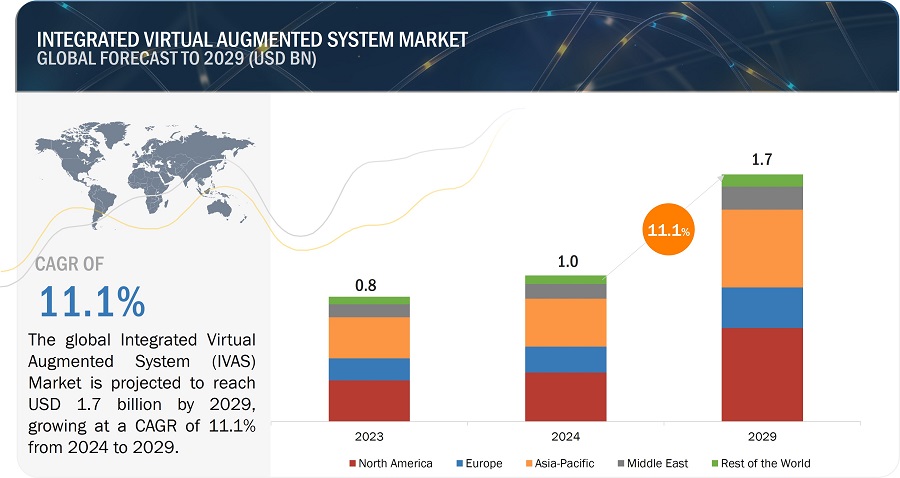The report “Integrated Visual Augmentation System Market by End-User (Air Force, Army, Navy), Product (Helmet Mounted Display, Night Vision Device), Technology (Augmented Reality, Virtual Reality, Mixed Reality), Application and Region – Global Forecast to 2029” The market is valued at USD 1.0 billion in 2024 and is projected to reach USD 1.7 billion by 2029, at a CAGR of 11.1% from 2024 to 2029.
Download PDF Brochure @ https://www.marketsandmarkets.com/pdfdownloadNew.asp?id=264968355
Browse 293 market data Tables and 72 Figures spread throug 265 Pages and in-depth TOC on “Integrated Visual Augmentation System Market”
View detailed Table of Content here – https://www.marketsandmarkets.com/Market-Reports/integrated-visual-augmentation-system-market-264968355.html
The Integrated Visual Augmentation System deals with enhancing military prowess by advanced augmented reality and mixed reality technologies. IVAS systems enhance situational awareness and operational efficiency by integration of cutting-edge visual interfaces and real-time data into the military training and combat environment. The key market players are Lockheed Martin Corporation (US), Elbit Systems, Ltd. (Israel), RTX (US), BAE Systems (UK), and Microsoft (US), thus pushing the market through innovations tailored for defense applications. Military modernization, rapid technological transformation, and huge investments by governments are some of the factors fueling the growth of the IVAS market since these vision systems enhance the realism in training and interoperability in network-centric warfare.
Based on the end-user, the air force segment is estimated to hold the highest market share during the forecast period.
Based on the end-user, the air force segment is estimated to lead the Integrated Visual Augmentation System Market from 2024 to 2029 These are now increasing due to the levelling effects and restricted access of commercial technologies. Commercial communications will always be less secure than the latest, most secure communications required by air forces to defend their national airspace and to assure superiority in their operations. Increasingly, these are collaborative. The integration of real-time data and situational awareness in the helmet visor enables pilots to make fast, high-quality decisions. This improves tactical advantage and pilot safety in high-tech, fast-paced aerial combat environments. The need for advanced, reliable, and integrated combat systems drives the development of sophisticated solutions like Striker II, which meets the evolving demands of modern aerial warfare and contested airspaces. These factors collectively drive the development and deployment of IVAS like helmet-mounted display, growing the global market for air force.
Based on product, the helmet mounted display segment is estimated to hold the highest market share during the forecast period.
Based on product, the helmet mounted display segment is estimated to hold the highest market share during the forecast period. The adoption and development of helmet-mounted displays (HMDs) are driven by several key factors across both military and civilian sectors. Enhanced situation awareness is important, and HMDs provide real-time, critical information directly in the line of sight, thus improving decision-making capabilities. Innumerable technologies, such as display technologies, sensor capabilities, miniaturization, etc., have undergone extensive development. Yet another important reason for their growth is that HMDs enable hands-free operations in situations where hand-operated activities are impossible or risky. They can be fitted into many other systems, including night vision, thermal imaging, and augmented reality, which improve their operational value. Besides, HMDs bring efficiency in operations through the smooth flow of critical information, thus becoming very effective in combat and complicated navigation situations. They record advanced training tools that provide simulation in a real environment that lets the trainee train and be better prepared.
Based on regions, the North America accounts for largest market share in Integrated Visual Augmentation System Market.
Based on region the North America Market is estimated to account for largest market share during the forecast period. North America is experiencing significant growth in the Integrated Visual Augmentation System (IVAS) market. This is supported by significant investments that the United States Department of Defense has made in military modernization and advanced technologies, especially in areas such as enhancing soldier lethality and situational awareness through AR and MR technologies. Another reason is the presence of leading technology companies like RTX Corporation, Microsoft recounted with large contracts by the U.S. Army for developing and fielding IVAS technologies that sealed its leadership in the region. These will ensure that each troop is equipped with state-of-the-art systems in real-time intelligence and operation capabilities, ensuring that North America does not get left behind in time by staying at the forefront of innovation in the military technology field concerning IVAS.
Key Players
The Integrated Visual Augmentation System Market is dominated by a few globally established players such as Lockheed Martin Corporation (US), Elbit Systems, Ltd. (Israel), RTX (US), BAE Systems (UK), and Microsoft (US).
Media Contact
Company Name: MarketsandMarkets™ Research Private Ltd.
Contact Person: Mr. Rohan Salgarkar
Email: Send Email
Phone: 18886006441
Address:1615 South Congress Ave. Suite 103
City: Delray Beach
State: FL 33445
Country: United States
Website: https://www.marketsandmarkets.com/Market-Reports/integrated-visual-augmentation-system-market-264968355.html
Press Release Distributed by ABNewswire.com
To view the original version on ABNewswire visit: Integrated Visual Augmentation System Market worth $1.7 Billion by 2029, at a CAGR of 11.1%

